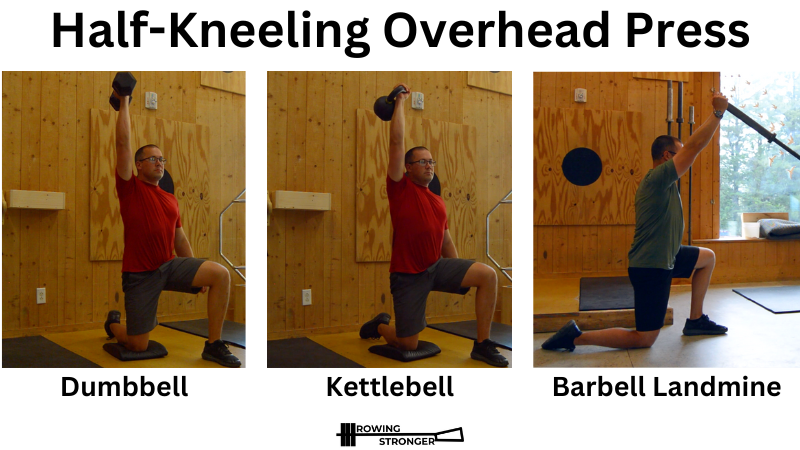Move of the Month: The Half-Kneeling Overhead Press
by GRP strength coach Will Ruth
The half-kneeling overhead press is where I start all athletes out on the overhead press exercise. We start here for a few main reasons. First, the half-kneeling position makes it easier to lock in the lower body and torso stability versus the standing position. Second, the down-knee leg gets some nice active mobility for the hip flexor muscles, usually a needed area for all athletes. Finally, like all unilateral exercises, the focus on just one limb working offers an opportunity to find and correct movement or muscle imbalances before moving to bilateral exercises. You can do the half-kneeling overhead press with a dumbbell, kettlebell, single weight plate, or barbell landmine attachment.
Overhead pressing is important for athletes to build strong shoulders and to train the skill of “scapulohumeral rhythm,” or how the shoulder blade and arm bone work together to produce efficient movement. Rowers use scapulohumeral rhythm in the horizontal plane to manage the oars smoothly throughout the stroke cycle; skiers do a similar movement, especially when double-poling; runners can improve arm swing and avoid common forward-shoulder impingement problems. I’ve found this to be a generalizable skill from vertical plane training. In other words, by training shoulder rhythm in multiple planes, we strengthen the muscles and the skill in the priority plane as well.
Key technique pointers:
The down-knee and working arm are paired: left knee on the ground means left arm doing the pressing.
Work for a straight vertical line from down-knee to hip through the braced torso to the shoulder and the weight in the fully overhead position. Keep the ribs and pelvis “stacked,” without arching the back, flaring the ribs, or tilting the hips.
The weight should rise before the shoulder joint elevates. Whether you row, run, or ski, connect this to the goal technique of the hands leading the body, not the shoulder jumping up or forward to move the hands.
Use a 2-to-1 lowering-to-lifting tempo with good control on the lowering phase and acceleration on the lifting phase of each rep.
Athletes of all ages and levels can begin the half-kneeling overhead press at a weight appropriate for their current level of movement coordination and strength. Those new to this exercise will need more time just working the movement at first, focusing on good technique with lower loads for 3-4 sets of 8-12 reps. As technique improves, we can increase the challenge of the exercise by increasing the load and using lower reps (3-5 sets of 4-8 reps) or higher reps (2-3 sets of 12-15 reps).
We often superset the half-kneeling overhead press with any other exercise that does not also work the upper body pushing muscles. It pairs well with a lower body movement like a deadlift or squat, as well as an upper body pulling movement like a row or chin-up variation. Do your weaker side first and then only match that output in reps or weight with your stronger side to gradually correct the imbalance. When you’re ready, progress from the half-kneeling overhead press to less stable, more challenging overhead press exercises. These can include the bottom-up kettlebell press, the one-arm standing press with no leg drive, the one-arm push press with leg drive, and two-arm overhead press exercises.

